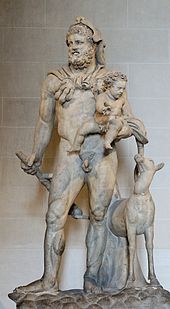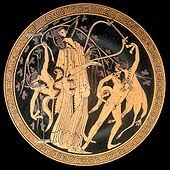The age in which the heroes lived is known as the heroic age. The epic and genealogical poetry created cycles of stories clustered around particular heroes or events and established the family relationships between the heroes of different stories; they thus arranged the stories in sequence. According to Ken Dowden, "there is even a saga effect: we can follow the fates of some families in successive generations".
After the rise of the hero cult, gods and heroes constitute the sacral sphere and are invoked together in oaths and prayers which are addressed to them. In contrast to the age of gods, during the heroic age the roster of heroes is never given fixed and final form; great gods are no longer born, but new heroes can always be raised up from the army of the dead. Another important difference between the hero cult and the cult of gods is that the hero becomes the centre of local group identity.
The monumental events of Heracles are regarded as the dawn of the age of heroes. To the Heroic Age are also ascribed three great military events: the Argonautic expedition, the Theban War and the Trojan War.
Heracles and the Heracleidae

Some scholars believe that behind Heracles' complicated mythology there was probably a real man, perhaps a chieftain-vassal of the kingdom of Argos. Some scholars suggest the story of Heracles is an allegory for the sun's yearly passage through the twelve constellations of the zodiac. Others point to earlier myths from other cultures, showing the story of Heracles as a local adaptation of hero myths already well established. Traditionally, Heracles was the son of Zeus and Alcmene, granddaughter of Perseus. His fantastic solitary exploits, with their many folk-tale themes, provided much material for popular legend. He is portrayed as a sacrificier, mentioned as a founder of altars, and imagined as a voracious eater himself; it is in this role that he appears in comedy, while his tragic end provided much material for tragedy — Heracles is regarded by Thalia Papadopoulou as "a play of great significance in examination of other Euripidean dramas". In art and literature Heracles was represented as an enormously strong man of moderate height; his characteristic weapon was the bow but frequently also the club. Vase paintings demonstrate the unparalleled popularity of Heracles, his fight with the lion being depicted many hundreds of times.
Heracles also entered Etruscan and Roman mythology and cult, and the exclamation "mehercule" became as familiar to the Romans as "Herakleis" was to the Greeks. In Italy he was worshipped as a god of merchants and traders, although others also prayed to him for his characteristic gifts of good luck or rescue from danger.
Heracles attained the highest social prestige through his appointment as official ancestor of the Dorian kings. This probably served as a legitimation for the Dorian migrations into the Peloponnese. Hyllus, the eponymous hero of one Dorian phyle, became the son of Heracles and one of the Heracleidae or Heraclids (the numerous descendants of Heracles, especially the descendants of Hyllus — other Heracleidae included Macaria, Lamos, Manto, Bianor, Tlepolemus, and Telephus). These Heraclids conquered the Peloponnesian kingdoms of Mycenae, Sparta and Argos, claiming, according to legend, a right to rule them through their ancestor. Their rise to dominance is frequently called the "Dorian invasion". The Lydian and later the Macedonian kings, as rulers of the same rank, also became Heracleidae.
Other members of this earliest generation of heroes, such as Perseus, Deucalion, Theseus and Bellerophon, have many traits in common with Heracles. Like him, their exploits are solitary, fantastic and border on fairy tale, as they slay monsters such as the Chimera and Medusa. Bellerophon's adventures are commonplace types, similar to the adventures of Heracles and Theseus. Sending a hero to his presumed death is also a recurrent theme of this early heroic tradition, used in the cases of Perseus and Bellerophon.


lovely writes!
OdgovoriIzbrišiThank you for pointing out this blog Kelfir from Scribd
OdgovoriIzbrišithank you this means alot!
OdgovoriIzbriši